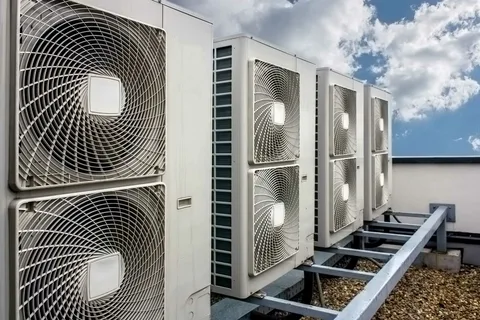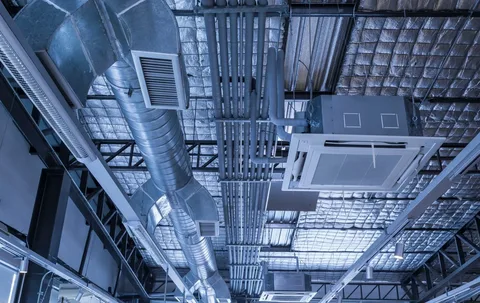Are you tired of feeling stuffy and stale air in your home? Do you want to experience the benefits of fresh and clean air every day? Look no further than an HRV. This powerful and efficient technology is designed to improve the air quality in your home, providing a constant supply of fresh air while also maintaining a comfortable temperature. In this blog post, we will explore the many uses and benefits of an HRV system, and how it can make a positive impact on your daily life. Get ready to breathe in freshness every day with an HRV in your home.
What is an HRV?
An HRV, or Heat Recovery Ventilation system, is a technology designed to improve the air quality in your home while also providing a constant supply of fresh air. It works by extracting stale air from inside your home and replacing it with fresh air from outside, all while maintaining a comfortable temperature.
HRV is made up of several key components, including an intake vent, an exhaust vent, a heat exchanger, and a fan. The intake vent brings fresh air into the home, while the exhaust vent removes stale air. The heat exchanger transfers the heat from the outgoing air to the incoming air, ensuring that the temperature in your home remains consistent.
This powerful and efficient technology has numerous uses in the home. It can help to remove indoor air pollutants such as dust, allergens, and odors, providing a healthier living environment for you and your family. HRV can also help to reduce humidity levels, preventing the growth of mold and mildew.
In addition to improving air quality, an HRV can also have energy efficiency benefits. By recovering heat from the exhaust air, it can reduce the amount of energy needed to heat or cool your home, ultimately lowering your energy bills.
Overall, an HRV is a valuable addition to any home, providing a constant supply of fresh air, improving indoor air quality, and reducing energy consumption. It’s a win-win for both your health and your wallet.
 Main Uses of an HRV in the Home
Main Uses of an HRV in the Home
One of the main uses of an HRV in the home is improving indoor air quality. With an HRV, you can say goodbye to stuffy air and hello to fresh and clean air every day. This technology helps to remove indoor air pollutants such as dust, allergens, and odors, creating a healthier living environment for you and your family. By continuously exchanging stale air with fresh air from outside, an HRV ensures that your home is filled with quality air throughout the day.
Another key use of an HRV is reducing humidity levels. High humidity can lead to the growth of mold and mildew, which can be detrimental to your health and your home. With an HRV, excess moisture is expelled, preventing the growth of these harmful substances.
Additionally, an HRV has energy efficiency benefits. By recovering heat from the exhaust air, it can reduce the amount of energy needed to heat or cool your home, ultimately lowering your energy bills.
In summary, the main uses of an HRV in the home include improving indoor air quality, reducing humidity levels, and increasing energy efficiency. It’s an investment that brings freshness and health into your daily life.
The Role of HRV in Indoor Air Quality Improvement
Indoor air quality is a crucial aspect of our overall health and well-being. Poor air quality can lead to various health issues, including respiratory problems, allergies, and even chronic illnesses. That’s where an HRV comes in.
The HRV plays a vital role in improving indoor air quality by constantly exchanging stale air with fresh air from outside. By removing indoor air pollutants such as dust, allergens, and odors, it creates a healthier living environment for you and your family. This is especially important for individuals with allergies or asthma, as it helps to reduce triggers and alleviate symptoms.
In addition to removing pollutants, the HRV also helps to regulate humidity levels. Excessive humidity can create an ideal environment for mold and mildew growth, which can be harmful to both your health and your home. The HRV expels excess moisture, preventing the growth of these harmful substances and ensuring a healthier living space.
Energy Efficiency Benefits of a HVAC System
When it comes to home comfort and energy efficiency, an HVAC system is a game-changer. Not only does it improve the air quality in your home, but it also offers a range of energy efficiency benefits. By recovering heat from the exhaust air and transferring it to the incoming fresh air, an HRV reduces the need for additional heating or cooling, ultimately lowering your energy bills. This means you can enjoy the benefits of fresh air without worrying about high energy costs.
But the energy efficiency benefits don’t stop there. By continuously exchanging stale air with fresh air, an HRV helps regulate the temperature in your home. This means your heating and cooling systems won’t have to work as hard to maintain a comfortable environment, resulting in even greater energy savings.
Additionally, an HRV can also reduce the load on your HVAC, which can prolong its lifespan and save you money on costly repairs or replacements in the long run. So not only will you be enjoying fresh and clean air every day, but you’ll also be saving money and reducing your carbon footprint.
Prolonging the Life of your HVAC with HRV
An HRV not only improves the air quality in your home and saves you money on energy bills, but it can also prolong the life of your HVAC. How? By reducing the workload on your heating and cooling systems.
When you have an HRV in place, it helps regulate the temperature in your home by continuously exchanging stale air with fresh air. This means that your HVAC doesn’t have to work as hard to maintain a comfortable environment. The reduced workload means less wear and tear on your HVAC, which can extend its lifespan.
Installing an HRV: Things to Consider
Installing an HRV in your home is a fantastic decision that will greatly improve your indoor air quality and energy efficiency. But before you go ahead and purchase an HRV, there are a few important things to consider.
First, it’s crucial to assess your home’s ventilation needs. Factors such as the size of your home, the number of occupants, and the layout of your space will all play a role in determining the size and capacity of the HRV you need. Consulting with a professional HVAC technician can help you determine the right system for your specific needs.
Next, you’ll need to think about the installation process. HRV requires proper ductwork installation to ensure optimal performance. It’s important to hire a qualified and experienced HVAC technician to handle the installation process and ensure that all components are correctly connected and sealed.
Finally, you’ll want to consider the cost of the HRV and its installation. While HRV offers long-term energy savings, the initial investment can vary depending on the size and features of the system. It’s important to budget for both the system itself and the installation costs to ensure a smooth and successful installation.
Maintenance and Care for Your HRV
Now that you have installed an HRV in your home, it’s important to understand how to properly maintain and care for it to ensure optimal performance and longevity. Here are some essential tips to keep in mind:
- Regular Filter Replacement: The filters in your HRV play a crucial role in removing pollutants from the incoming air. It is recommended to check and replace the filters every three to six months, or as directed by the manufacturer. Clean filters will ensure that your system operates efficiently and effectively.
- Cleaning the Ventilation System: Over time, dust and debris can accumulate in the ventilation system, reducing airflow and potentially impacting air quality. Regularly clean the intake and exhaust vents, as well as the heat exchanger, according to the manufacturer’s instructions. This will help to maintain proper airflow and prevent the buildup of contaminants.
- Professional Maintenance: It is a good idea to schedule annual maintenance visits with a qualified HVAC technician. They can inspect your HRV, clean and lubricate components, check for any issues, and ensure that everything is functioning properly. This proactive approach can prevent potential problems and extend the lifespan of your HRV.
- Monitoring Humidity Levels: Keep an eye on the humidity levels in your home, as excessive moisture can promote the growth of mold and mildew. If you notice high humidity, consider using a dehumidifier in conjunction with your HRV to maintain optimal indoor air quality.
FAQs
Got some burning questions about HRV? We’ve got you covered! Check out these frequently asked questions to get all the answers you need:
Q: What is the difference between an HRV and an ERV system?
A: While both HRV (Heat Recovery Ventilation) and ERV (Energy Recovery Ventilation) systems improve indoor air quality, they differ in their ability to transfer moisture. HRV transfers heat only, while ERV systems transfer both heat and moisture. If you live in a humid climate, an ERV system may be more beneficial.
Q: How often should I replace the filters in my HRV?
A: It is recommended to check and replace the filters in your HRV every three to six months, or as directed by the manufacturer. Clean filters will ensure that your system operates efficiently and effectively.
Q: Can I install an HRV myself?
A: While some homeowners may have the skills to install an HRV themselves, it is generally recommended to hire a qualified HVAC technician for proper installation. They have the expertise and knowledge to ensure all components are correctly connected and sealed.
Conclusion
In a world where indoor air quality and energy efficiency are increasingly important, an HRV is a game-changer. This powerful technology improves the air quality in your home, removes indoor air pollutants, regulates humidity levels, and reduces energy consumption. With an HRV, you can say goodbye to stale and stuffy air and hello to freshness and comfort every day.



